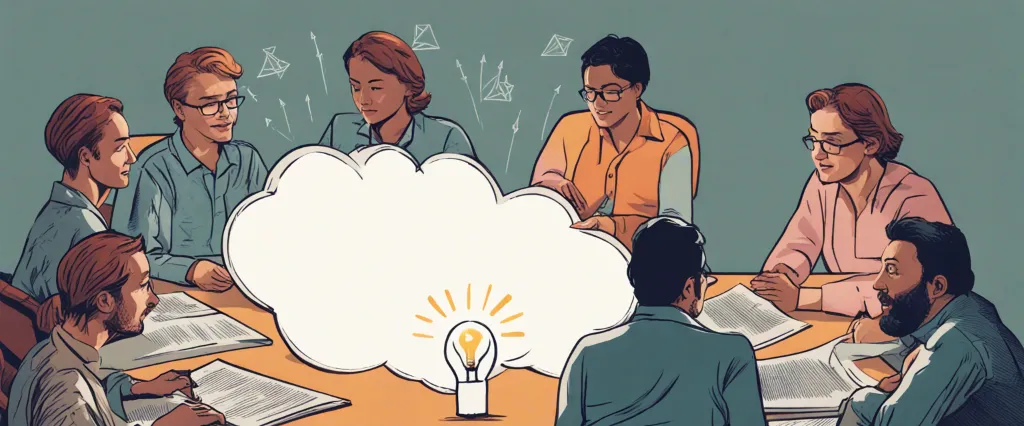In The Wisdom of Crowds by James Surowiecki acclaimed author James Surowiecki explores the fascinating concept that collective decision-making can often result in superior outcomes when compared to those made by individuals or experts. By delving into diverse case studies and drawing from various disciplines, Surowiecki uncovers the mechanics behind this phenomenon and sheds light on how the wisdom of crowds can be harnessed to make wiser and more accurate decisions. As a renowned journalist and staff writer for The New Yorker, James Surowiecki has extensively written on the intersection of economics, psychology, and social behaviors. His insightful perspectives and thorough analysis make him a leading authority in understanding the potential of collective intelligence and the power it holds in shaping our world.
Chapter 1: Collective Intelligence: Harnessing the power of diverse perspectives
Chapter 1 of “The Wisdom of Crowds” written by James Surowiecki, titled “Collective Intelligence: Harnessing the power of diverse perspectives,” introduces the concept of how a group of people can make better decisions collectively than any individual member. The chapter emphasizes the potential of collective intelligence, which arises from the aggregation of diverse perspectives, and provides several examples to support this idea.
Surowiecki begins by discussing the surprising accuracy of a crowd’s estimation of the weight of an ox at a county fair, which exceeds the guesses of most individuals in the crowd. This showcases the concept of “wisdom of crowds,” where the average opinion of the group tends to be more accurate than the opinions of individual experts. This phenomenon occurs because even though individuals may have varying levels of knowledge or abilities, the errors in their judgment cancel out when aggregated.
The author further highlights the significance of diversity within a crowd, stating that a diverse group of individuals with different backgrounds, perspectives, and experiences can provide a wide range of information and insights. This diversity helps the collective intelligence of the crowd in generating accurate solutions, making informed decisions, and solving complex problems.
Surowiecki emphasizes that for collective intelligence to be effective, there are certain conditions that need to be met. These include a diverse group, independence of thought, decentralization, and a mechanism to aggregate opinions. When these conditions are present, the wisdom of crowds can bring benefits across various areas, such as business, politics, and technology.
In conclusion, Chapter 1 of “The Wisdom of Crowds” introduces the concept of collective intelligence and highlights the power of diverse perspectives within a group. It illustrates how diverse groups can collectively make more accurate decisions than individuals alone, emphasizing the importance of combining varied knowledge and viewpoints for better outcomes.
Chapter 2: The Diversity Factor: Importance of varied opinions and backgrounds
Chapter 2 of “The Wisdom of Crowds” by James Surowiecki, titled “The Diversity Factor: Importance of varied opinions and backgrounds,” delves into the significance of diversity within a group and its impact on decision-making processes and outcomes. Surowiecki argues that a diverse group, composed of individuals with different perspectives and backgrounds, is more likely to produce accurate and effective decisions compared to a homogenous group.
The chapter begins with the example of Francis Galton’s experiment at a country fair, where participants were asked to guess the weight of an ox. While many individuals made incorrect guesses, the average of all the guesses was astonishingly accurate, almost exactly the ox’s true weight. Surowiecki attributes this accuracy to the collective intelligence of the diverse crowd, stating that diverse opinions and viewpoints cancel out individual errors, resulting in a more informed group decision.
Furthermore, Surowiecki highlights three main reasons why diversity is crucial for the wisdom of crowds to manifest. Firstly, diverse individuals bring different information and insights, expanding the pool of collective knowledge within the group. Secondly, cognitive diversity allows for a wider range of perspectives and interpretations of problems or situations, enabling the group to consider various alternatives and possibilities. Lastly, diverse individuals bring varied decision-making heuristics, reducing the likelihood of biases and errors that can occur with conformity and groupthink.
The author also acknowledges the challenges of diversity, such as communication barriers and conflicts that arise from contrasting opinions. However, Surowiecki argues that these obstacles can be managed with effective communication and facilitation techniques, ultimately leading to more successful decision-making.
In conclusion, Chapter 2 emphasizes the importance of diversity within a group in harnessing the collective intelligence and wisdom of crowds. By embracing differences in opinions, backgrounds, and perspectives, groups can make more accurate and effective decisions while mitigating the risks of biases and errors that may exist in homogenous groups.
Chapter 3: Decentralization: Examining the benefits of distributed decision-making
Chapter 3 of “The Wisdom of Crowds” by James Surowiecki explores the concept of decentralization and the advantages of distributed decision-making. Surowiecki argues that groups, when organized correctly, can make superior decisions compared to individuals or a centralized authority.
The chapter begins by highlighting a historical example: the sinking of the USS Scorpion submarine. This incident occurred due to a critical design flaw that could have been avoided if decisions were made collectively by different experts within multiple areas. This serves as a powerful illustration of the potential dangers of relying solely on centralized decision-making.
Surowiecki then discusses the concept of diversity within groups, emphasizing that having a wide range of perspectives is crucial for effective decision-making. He explains that diverse viewpoints lead to a more comprehensive analysis of problems and offer a higher chance of finding suitable solutions.
The chapter delves into the idea that decentralized decision-making allows for collective intelligence to emerge. By tapping into the thoughts and ideas of many, rather than relying solely on the input of a few, a group can utilize its collective knowledge and experiences to make better overall judgments.
Additionally, the author introduces the concept of prediction markets, which are decentralized platforms where people can bet on the likelihood of future events. Surowiecki highlights how these markets have proved to be more accurate than traditional experts in forecasting outcomes. Prediction markets work by aggregating the knowledge and opinions of many individuals who have some investment in the outcome, creating a reliable and decentralized forecasting tool.
In summary, chapter 3 explores how decentralization and distributed decision-making can lead to better outcomes by incorporating diverse perspectives and collective intelligence. It emphasizes the value of tapping into the wisdom of crowds for more accurate analysis and decision-making.
Chapter 4: Aggregating Information: How to effectively gather and combine knowledge

Chapter 4 of “The Wisdom of Crowds” by James Surowiecki is titled “Aggregating Information: How to effectively gather and combine knowledge.” This chapter focuses on the process of gathering and consolidating information from a diverse group of individuals in order to make better decisions.
Surowiecki argues that collective intelligence can be highly effective when it comes to problem-solving and decision-making. He presents various examples where groups outperformed experts or individuals in predicting outcomes or solving complex problems. The key to harnessing the collective intelligence lies in effective aggregation of information.
The author discusses four main principles for aggregating information: diversity, independence, decentralization, and aggregation. Diversity is important as it brings different perspectives and knowledge to the table, increasing the range of possible solutions. Independence ensures that each person’s judgement is not influenced by others, allowing for unbiased opinions. Decentralization, or allowing individuals to make decisions independently, helps avoid the groupthink phenomenon.
Surowiecki explains that aggregation is the process of combining individual opinions to form a collective decision. He emphasizes the importance of weighted voting, where the influence of each person’s opinion is determined by their expertise or accuracy in the past. This ensures that more knowledgeable individuals have a higher weight in the decision-making process.
The author also explores the role of prediction markets, where financial incentives are used to encourage individuals to make accurate predictions. These markets have proven to be remarkably successful in forecasting outcomes, such as election results or stock market trends.
In conclusion, Chapter 4 of “The Wisdom of Crowds” highlights the effectiveness of gathering and combining diverse knowledge through principles like diversity, independence, decentralization, and aggregation. By utilizing these methods, groups can tap into the collective intelligence of their members to make more accurate and informed decisions.
Chapter 5: Wisdom of Crowds: Understanding the collective intelligence phenomenon
Chapter 5 of “The Wisdom of Crowds” by James Surowiecki delves deeper into the concept of collective intelligence and how it works. The chapter focuses on five key conditions that are necessary for a crowd to be wise.
Firstly, diversity of opinion is essential. Surowiecki highlights that a crowd is more likely to be wise when it consists of individuals with different perspectives and information. These diverse opinions create a broader range of knowledge, making collective decisions more informed.
Secondly, independence of decision-making is crucial. If individuals in a crowd are influenced by the opinions or judgments of others, the wisdom of the crowd diminishes. Independent thinking allows people to contribute their unique insights, uninfluenced by external pressures.
Thirdly, decentralization plays a role in effective crowdsourcing. A decentralized crowd, where individuals’ decisions are not dictated by a central authority or hierarchy, tends to make more accurate and informed decisions. This allows for a better aggregation of diverse opinions.
Fourthly, an effective aggregation of information is necessary. Surowiecki explains that collective intelligence emerges when the opinions of individuals are combined and processed. The accuracy of the collective decision depends on the method used to aggregate these individual opinions.
Lastly, Surowiecki emphasizes the importance of a mechanism for the crowd to arrive at a collective decision. Whether it be voting, an auction, or a prediction market, the mechanism must be able to tap into the collective intelligence effectively.
This chapter provides a detailed understanding of the conditions required for a crowd to exhibit wisdom. By explaining the significance of factors such as diversity, independence, decentralization, aggregation, and decision-making mechanisms, Surowiecki highlights how crowdsourcing can harness the collective intelligence of a group.
Chapter 6: Making Better Decisions: Leveraging collective wisdom for improved outcomes
Chapter 6 of “The Wisdom of Crowds” explores the concept of leveraging collective wisdom for better decision-making and improved outcomes. Author James Surowiecki highlights the power of diverse and independent individuals coming together to make decisions as a group, pointing out that under certain circumstances, the collective judgment of the crowd can be remarkably accurate and reliable.
The chapter starts by illustrating how collective decision-making can be effective in a variety of scenarios. From predicting outcomes in sports and elections to making investment decisions, Surowiecki argues that aggregating the opinions of numerous individuals can actually yield more accurate predictions than those of experts.
However, this collective wisdom is not infallible. The author emphasizes the importance of certain key factors for tapping into the wisdom of crowds. Firstly, diversity within the crowd is crucial, as a homogenous group tends to lead to biased and flawed decision-making. The more diverse the group is in terms of backgrounds, perspectives, and expertise, the better the collective judgment.
Secondly, independence plays a critical role in harnessing collective wisdom. When people are influenced by each other’s opinions or dominated by a leader, the crowd’s judgment can be skewed. Encouraging independent thinking and allowing individuals to form their own opinions is essential to avoid groupthink and achieve unbiased outcomes.
Lastly, the chapter highlights that aggregation mechanisms are necessary to collect and combine individual judgments effectively. Various methods such as voting or averaging opinions provide a framework for aggregating diverse perspectives and creating a collective decision.
Through exploring case studies and real-life examples, Surowiecki reveals the potential for leveraging collective wisdom in decision-making. By embracing diversity, independence, and effective aggregation mechanisms, groups can tap into the intelligence of the crowd, leading to improved outcomes and better decisions.
Chapter 7: Avoiding Groupthink: Overcoming biases and pitfalls in group decision-making
Chapter 7 of “The Wisdom of Crowds” by James Surowiecki delves into the concept of group decision-making and the potential biases and pitfalls that may arise within a collective decision-making process. The author seeks to address the issue of “groupthink” and suggests ways to avoid it.
Surowiecki begins by highlighting the risk of conformity and the suppression of dissenting opinions that often arise in group settings. Groupthink occurs when members of a group prioritize harmony and consensus over critical evaluation, leading to flawed decisions. This is often driven by social pressures, fear of being ostracized, or the desire to maintain group cohesion.
To overcome biases and pitfalls, the author presents various strategies that foster effective group decision-making. First, he emphasizes the importance of diversity within a group, as differing perspectives and experiences can lead to more insightful and varied opinions. By encouraging individuals to freely express dissenting views, the group can avoid the dangers of groupthink and consider a broader range of possibilities.
Surowiecki also explores the concept of decentralized decision-making, where decisions are made closer to the source of information or expertise. By distributing decision-making power, groups can tap into the wisdom of individuals who possess specialized knowledge, leading to more accurate and informed choices.
Furthermore, the author emphasizes the significance of creating a culture that encourages constructive criticism and rewards challenging the status quo. By fostering an environment that values independent thinking and diverse perspectives, the group can actively avoid groupthink and make better decisions collectively.
In summary, Chapter 7 of “The Wisdom of Crowds” highlights the dangers of groupthink in group decision-making. By promoting diversity, decentralizing decision-making, and fostering a culture of constructive criticism, groups can overcome biases and pitfalls, ultimately making more informed and effective decisions.

Chapter 8: Applications and Implications: Real-world examples and implications of collective intelligence
Chapter 8 of “The Wisdom of Crowds” by James Surowiecki explores real-world applications and implications of collective intelligence. The chapter delves into various examples across different fields, demonstrating how groups can make better decisions than individuals.
One prominent application discussed is prediction markets. Surowiecki illustrates how these markets, where people buy and sell shares based on their predictions of future events, have successfully forecasted outcomes ranging from political elections to box office performance. The aggregated knowledge and diverse perspectives of participants in prediction markets often outperform individual experts or surveys.
Another example highlighted is open-source software development. Surowiecki illustrates how the collaborative efforts of countless programmers worldwide have resulted in innovative and reliable software products like Linux and Apache. He highlights the power of collective intelligence in identifying and fixing bugs, enhancing security, and driving continuous improvement.
The concept of collective intelligence is also applied to the field of criminal investigations. Surowiecki discusses how open-source platforms such as Innocentive and iBridge have harnessed collective problem-solving, enabling diverse groups of “solvers” to provide novel solutions for complex challenges like scientific research and new product development.
Furthermore, the chapter explores the implications of collective intelligence, addressing topics such as the potential pitfalls of group decision-making (such as groupthink) and the importance of diversity within a crowd to ensure varying perspectives and insights. Surowiecki emphasizes the need for optimization in decision-making processes to harness the true power of collective intelligence.
Overall, Chapter 8 of “The Wisdom of Crowds” provides tangible examples of how collective intelligence has been applied across different sectors, highlighting its potential for creating better outcomes and solutions. Surowiecki stresses the importance of understanding and leveraging collective intelligence effectively for individuals, organizations, and society as a whole.
After Reading
In conclusion, “The Wisdom of Crowds” by James Surowiecki explores the idea that when a diverse group of individuals with independent opinions are brought together, their collective wisdom often surpasses that of any one expert. Surowiecki examines several real-world examples, such as the accuracy of crowd predictions and the success of open source communities, to support his argument. He also presents the conditions necessary for crowds to be wise, including diversity, independence, decentralization, and an appropriate means of aggregating individual opinions. Overall, Surowiecki’s thought-provoking analysis challenges our conventional understanding of decision-making and highlights the potential power and effectiveness of collective intelligence.
1. The Signal and the Noise: Why So Many Predictions Fail – But Some Don’t” by Nate Silver: Exploring the art of prediction, Silver delves into the challenges of distinguishing signal from noise in a world saturated with data, offering valuable insights into making accurate forecasts.
2. “The Wisdom of Crowds: Why the Many Are Smarter Than the Few and How Collective Wisdom Shapes Business, Economies, Societies, and Nations” by James Surowiecki: This book, similar in theme but distinct from Surowiecki’s work, explores the power of collective intelligence and how it can shape various aspects of our world.
3. The Crowd: A Study of the Popular Mind” by Gustave Le Bon: A classic work on crowd psychology, Le Bon examines how individuals behave when part of a larger group, shedding light on the dynamics and potential pitfalls of collective decision-making.
4. Thinking, Fast and Slow” by Daniel Kahneman: Drawing on decades of research, Kahneman explores the two systems of thinking that drive our decisions, highlighting the biases and heuristics that can hinder accurate judgments, making it relevant to understanding collective decision-making processes.
5. “The Wisdom of the Enneagram: The Complete Guide to Psychological and Spiritual Growth for the Nine Personality Types” by Don Richard Riso and Russ Hudson: While not directly focused on crowds, this book offers profound insights into the nine personality types, helping individuals understand themselves and others better, which can inform collective interactions and decision-making.




